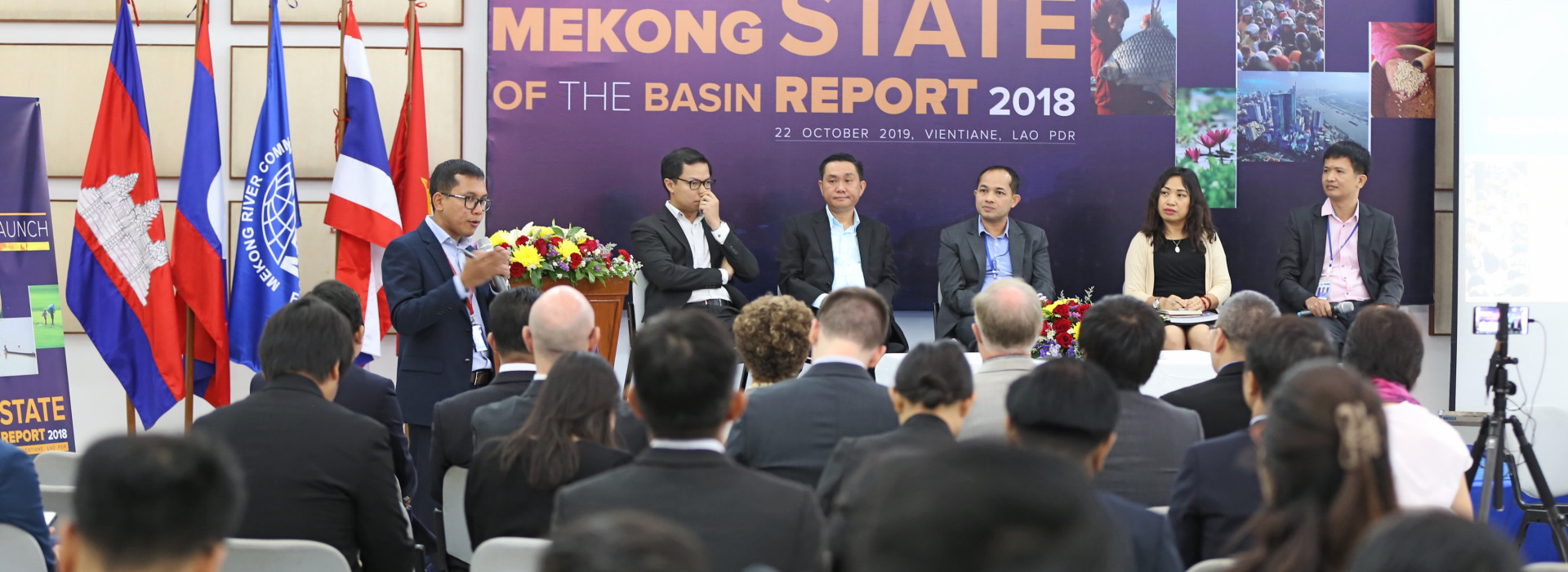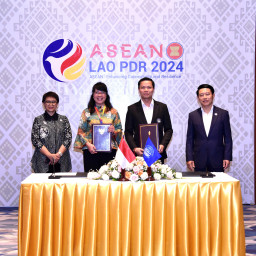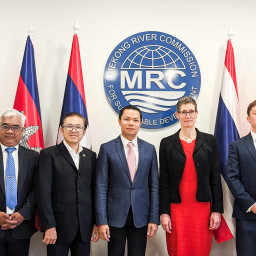Mekong water related resources need urgent protection, better planning and management, says a new MRC report
Vientiane, Lao PDR, 22 October 2019 — The apparent permanent modification of mainstream flow regime, the substantial reduction in sediment flows due to sediment trapping, the continuing loss of wetlands, the deterioration of riverine habitats, the growing pressures on capture fisheries, and the limited information sharing on current water development facilities and water use are some of the major challenges facing countries in the Mekong, says a new report by the Mekong River Commission (MRC).
A more proactive regional approach to basin planning and management, with an enhanced and systematic information sharing mechanism and robust monitoring of river flow must be put in place urgently to address these basin-wide challenges, according to findings and recommendations of the MRC State of the Basin Report (SOBR) 2018 released today during an official launch at the MRC Headquarters in Laos’ capital city Vientiane.
CEO of MRC Secretariat Dr. An Pich Hatda addresses the audience at the official launch of the Mekong State of the Basin Report 2018 today at the MRC Headquarters in Laos’ capital city Vientiane.
“We need to address these issues now in order to minimize further environmental harm and protect remaining wetlands and riverine habitats before they are gone, while leveraging the benefits of more secure and increased dry season flows and achieving a more optimal and sustainable development of the Mekong basin,” Dr. An Pich Hatda, Chief Executive Officer of the MRC Secretariat, said at the ceremony, which brought together some 90 officials from the MRC Member Countries and members of diplomatic corps, MRC’s development partners, local and international NGOs, and MRC Secretariat staff.
According to the report, there is also an increased cooperation among riparian countries to tackle these challenges, especially under the MRC framework where financial contributions from members to fund MRC critical work, notifications and information sharing, and the number of joint projects have all increased.
While challenges are increasing for the Mekong River, the overall economic conditions in the basin are positive with solid economic growth, poverty reduction and productivity improvement.
The 226-page long report aims to assess conditions within the basin and the impacts, both positive and negative, that developments and use of the water and related natural resources create. It is intended to provide a statement of past trends and current conditions within the basin and to track changes brought about by the cooperation envisaged under the 1995 Mekong Agreement. It also seeks to highlight significant issues as well as apparent development opportunities that the Member Countries may wish to take up.
Compiled about every five years based on facts and figures of available data and information, the SOBR covers five critical dimensions that decision makers and basin planners and managers should know, including environmental, social and economic conditions, climate change and cooperation. In addition, and for the first time, the report includes a review of conditions within the upper Mekong basin.
French Ambassador to Lao PDR Mme Florence Jeanblanc-Risler asks a panel of experts on the report during the official launch in Vientiane
Development and operation of the upper Mekong hydropower cascade, which are mostly storage dams, has significantly increased dry season flows, reduced wet season flows, and reduced the sediment budget of the Mekong River, according to the report. This has brought both opportunities and risks. The report also notes the ongoing and increased efforts in China and Myanmar on environment protection including the cancelation of a planned mainstream dam.
In light of these findings, the SOBR provides many key strategic recommendations. Chief among them are the recommendations to continue efforts to strengthen cooperation between China and the lower Mekong countries to ensure effective upper and lower Mekong basin-wide river basin management in order to allow for sustainability of all benefits provided by the river.
There is also a recommendation for the MRC Member Countries, partners and stakeholders to consider when updating the next Basin Development Strategy (BDS) – a high-level document that identifies issues faced in developing and managing the water and related resources of the lower Mekong basin and that sets a strategy by which the Member Countries agree to collectively address.
This recommendation is for the updated BDS to consider, among other aspects, expanding and enhancing monitoring of flow conditions and water quality, developing and implementing a central data acquisition and enhanced mechanism, addressing the problems of reducing sediment concentrations, and preserving and protecting environmental assets.
“Building on the findings and recommendations, the MRC and its partners and stakeholders will need to work stronger and closer together to address the raised issues using the Basin Development Strategy and MRC Strategic Plan that are being updated,” Dr. Hatda said.
Note to editors:
The MRC is an intergovernmental organisation for regional dialogue and cooperation in the lower Mekong river basin, established in 1995 based on the Mekong Agreement between Cambodia, Lao PDR, Thailand and Viet Nam. The organisation serves as a regional platform for water diplomacy as well as a knowledge hub of water resources management for the sustainable development of the region.
- END -





